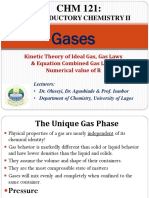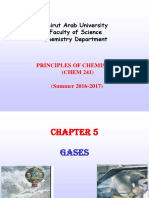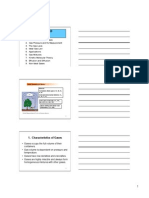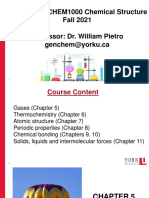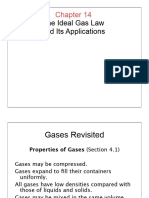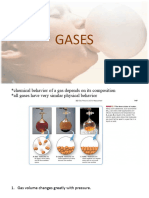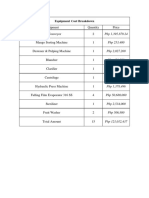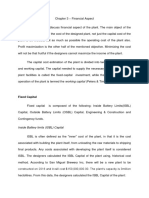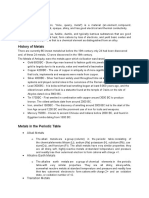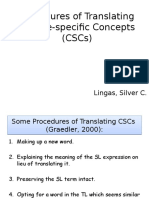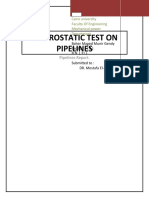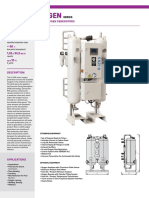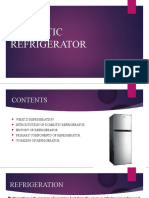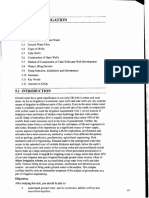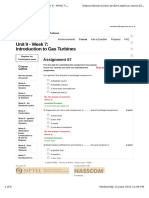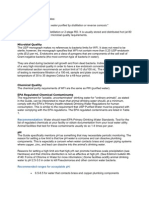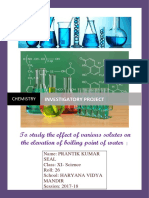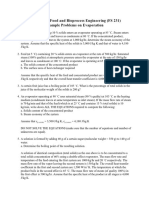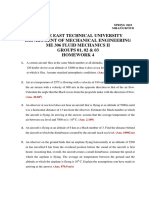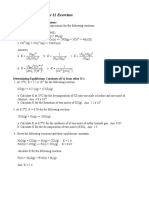Chapter 5 Gases
Chapter 5 Gases
Uploaded by
Kevin MellizaCopyright:
Available Formats
Chapter 5 Gases
Chapter 5 Gases
Uploaded by
Kevin MellizaOriginal Description:
Copyright
Available Formats
Share this document
Did you find this document useful?
Is this content inappropriate?
Copyright:
Available Formats
Chapter 5 Gases
Chapter 5 Gases
Uploaded by
Kevin MellizaCopyright:
Available Formats
Chapter 5 Review: Gases
Section 1: Pressure
Pressure: the pressing of the particles of a gas against its surroundings
Atmospheric pressure is the result of the masses of the gases in Earths
atmosphere being pulled to Earth due to gravity
A barometer is a device that measures atmospheric pressure
o A glass tube filled with mercury is flipped into a container of mercury
o Atmospheric pressure measured in height of Hg in mm
o Averages 760 mmHg at sea level
o Higher in atmosphere = lower height of Hg
Since Pressure is the force per unit area:
o Pressure = force/area
o Newtons per square meter = pascal (Pa)
Section 1: Pressure
Unit Conversions
o X mm Hg = X torr
o 760 torr = 1 atm
o 1 atm = 101,325 Pa
The pressure of a gas is measure to be 49 torr. Convert this to both
atmospheres and pascals.
Section 2: Gas Laws
Boyles Law
Boyle studied relationship between pressure and volume using a J
shaped tube closed at one end.
As volume decreases, pressure increases [inverse relationship]
PV = k (where k is a constant for a given sample of air at a given temp.)
so: P1V1 = P2V2
Used for predicting new volume of gas after changing pressure or new
pressure of gas after changing volume
If the pressure of a 1.53 L sample of gaseous SO2 is changed from
5.6x103 Pa to 1.5x104 Pa, what will be the new volume of the gas?
Does the answer make sense?
Section 2: Gas Laws
The temperature and the amount of mole of gas are remained constant
Gases that strictly obey Boyles Law are called ideal gases, but the law is
only precise at low pressures. Many deviations occur at higher pressure
readings.
If you were to plot a P vs. V graph and then a V vs 1/P graph, you would
have a hyperbola.
Section 2: Gas Laws
Charless Law
o Charles found that volume of gas increases as temperature increases
at constant pressure [direct relationship]
o The volume of all gases at -273oC would theoretically be 0
o K = oC + 273
o At 0 Kelvin, the volumes of the gases extrapolate to zero, so anything
less than that and the volume would be negative (not possible)
o 0 K is called absolute zero
o V = bT where T is in Kelvins and b is a proportionality constant
o So V/T = b or V1/T1,= V2/T2
o A sample of a gas at 15oC has a volume of 2.58L. What volume will
this gas occupy at 38oC (assuming constant pressure)?
Section 2: Gas Laws
Plot V vs. T and you will have a linear line with a positive slope.
Section 2: Gas Laws
Avogadros Law
o The same volumes of gas at the same pressure and temperature have
the same number of particles.
o V = an where V is volume of gas, n is the number of moles of gas
particles and a is a proportionality constant
o Number of particles increases, volume increases [directly proportional]
o V/n = a so V1/n1 = V2/n2
o An 11.2 L sample of gas contains 0.50 mol N2. At the same temp. and
pressure, how many moles of gas would there be in a 20. L sample?
Section 2: Gas Laws
Gay Lussacs Law
Gay Lussac studied gases with constant volume and constant amount of
moles and found that Pressure is directly related to Kelvin T.
P = bT where T is in Kelvins and b is a proportionality constant
So P/T = b or P1/T1,= P2/T2
Plot P vs T and you will get a linear line with a positive slope
note that all of these laws hold true for ideal gases of which there are none
so there are only deviations, but we can come close.
A 20 L cylinder containing 6 atm of gas at 27 C. What would the pressure
of the gas be if the gas was heated to 77 C?
Section 3: Ideal Gas Law
Boyles Law:
V = k/P
Charless Law:
V = bT
Avogadros Law: V = an
These relationships can be combined to form the equation:
o V = R (Tn / P) where R is the combined proportionality constant called
the universal gas constant
o When pressure is in atm and volume is in L, R = 0.08206 L*atm / K*mol
o More familiar form of ideal gas law: PV = nRT
A gas that behaves exactly as the equation is said to behave ideally
The ideal gas law expresses the behavior the real gases approach at low
temperatures and high pressures
So and ideal gas is a hypothetical substance, however most gases behave
the equation close enough at pressures below 1 atm that errors are minimal
Section 3: Ideal Gas Law
1. A sample of hydrogen (H2) gas has a volume of 8.56 L at a temperature of
0oC and a pressure of 1.5 atm. Calculate the moles of H2 molecules present
in this gas sample.
2. A sample of diborane gas (B2H6) has a pressure of 345 torr at a temperature
of -15oC and a volume of 3.48 L. If conditions are changed so that the
temperature is 36oC and the pressure is 468 torr, what will be the volume of
the sample?
Section 4: Gas Stoichiometry
If we have one mole of an ideal gas at STP (0o Celsius and 1 atm) than the
volume found using the ideal gas law is
((1.000mol) x (.08026 L x atm/K x mol) x (273.2 K)/1.000 atm) = 22.42
This volume is the molar volume of an ideal gas. Of course, no gas actually
has a molar volume of 22.42, but there are close deviations.
A sample of methane gas having a volume of 2.80 L at 25o Celsius and
1.65 atm is mixed with a sample of oxygen gas having a volume of 35.0 L
31.0o Celsius and 1.25 atm. The mixture is then combusted. Calculate the
volume of carbon dioxide formed at a pressure of 2.50 atm and a
temperature of 125o Celsius.
Section 4: Gas Stoichiometry
Molar mass of gas
From the measured density, you can find the molar mass of gas using the
ideal gas equation.
n= (grams gas/molar mass) = m/molar mass
substitute into ideal gas equation(m/molar mass)RT/V = mRT/V(molar mass)
since mass/volume = density
P= (dRT)/molar mass
The density of a gas was measured at 1.50 stm and 27oC and found to be
1.95 g/L. Calculate the molar mass of the gas.
Section 5: Law of Partial Pressures
Daltons Law of Partial Pressures, as summarized by dalton:
o For a mixture of gases in a container, the total pressure exerted is the
sum of the pressures that each gas would exert if it were alone
o PTOTAL = P1 + P2 + P3 + ..... where the subscripts represent individual
gases (gas 1, gas 2 and so on)
o The symbols P1, P2, P3, and so on represent each partial pressure, or the
pressure the individual gas would exert on the container if it were alone.
Assuming each gas behaves ideally, the partial pressure of each gas can be
calculated using the ideal gas law eaquation:
o P1 = (n1RT) / V
P2 = (n2RT) / V
P3 = (n3RT) / V
.
So:
o PTOTAL=P1+P2+P3+...= (n1RT)/V + (n2RT)/V + (n3RT)/V + ... = (n1+n2+n3+...)
Section 5: Law of Partial
Pressures
Assuming each gas behaves ideally, the partial pressure of each gas can
be calculated using the ideal gas law equation:
o P1 = (n1RT) / V
P2 = (n2RT) / V
P3 = (n3RT) / V
.
So:
o PTOTAL= P1 +P2 +P3 + =
o PTOTAL= (n1RT)/V + (n2RT)/V + (n3RT)/V + ... =
o PTOTAL= (n1+n2+n3+...)(RT/V) =
o PTOTAL= nTOTAL(RT/V) Where nTOTAL is the sum of the numbers of
moles of the different gases
Its the number of moles present thats important, not the volume of the gas
particles nor the forces among the particles (for ideal gases).
Section 5: Law of Partial
Pressures
Consider the three flasks in the diagram below. Assuming the connecting
tubes have negligible volume, what is the partial pressure of each gas and
the total pressure when all the stopcocks are opened?
First flask: He --- 200. torr, 1.00L
Second flask: Ne --- 0.400 atm, 1.00L
Third flask: Ar --- 24.0 kPa, 2.00 L
Section 6: Kinetic Molecular Theory of
Gases
Ideal gases:
Assume that there are no particle interactions- elastic collisions
They are infinitely small- point mass. Gases molecules have volume
though.
Particles are in constant motion. Increased temperature will increase
frequency and strength of collision between wall and particles- increased
pressure.
Average kinetic energy of gas particles is assumed to be directly
proportional to the Kelvin temperature of the gas.
Van der waals equation
Section 7: Effusion and
Diffusion
Effusion is the term used to describe the rate at which a gas can be
transferred through a tiny opening into an evacuated chamber.
Thomas Grahams Law
(ma/mb)1/2= Vb/Va
The rate of a gas is inversely proportional to the square root of the mass of
its particles.
The relative rates of effusion of two gases held at the same pressure and
temperature are given by the inverse ratio of the square roots of the
masses of the particles.
A 3.00 L sample of helium was placed in container fitted with a porous
membrane. Half of the helium effused through the membrane in 25 hours.
A 3.00 L sample of oxygen was placed in an identical container. How many
hours will it take for half of the oxygen to effuse through the membrane?
Section 7: Effusion and
Diffusion
Diffusion is the rate of the mixing of gases
Because so many collisions with oxygen and nitrogen occur as molecules
try to diffuse, diffusion is complicated to describe theoretically.
Section 8: Real Gases
No gas follows the ideal gas law exactly, however many gases at low pressure
and high temperature come close.
To correct the assumptions made by the Kinetic Molecular Theory, Johannes
van der Waals modified the ideal gas law for real gases :
P=((nRT)/(V-nb)) - a(n/V)2
or
(P + a(n/V)2)x (V-nb) = nRT
This takes into account molecular size(b) and molecular interaction forces(a).
b will be greater for large particles and a is higher for polar molecules.
You might also like
- GASESDocument101 pagesGASESdwyquishNo ratings yet
- Chapter 1 - Gas LawDocument52 pagesChapter 1 - Gas LawLolindah ChinNo ratings yet
- 6 Gases PDFDocument70 pages6 Gases PDFRogerine RoyNo ratings yet
- The Kinetic Molecular Theory: General Chemistry 1 Reviewer: 2nd QuarterDocument15 pagesThe Kinetic Molecular Theory: General Chemistry 1 Reviewer: 2nd QuarterJerome jeromeNo ratings yet
- Gas Laws LecDocument43 pagesGas Laws LecJune Francis AngNo ratings yet
- Lesson 2A Gas Laws 2Document22 pagesLesson 2A Gas Laws 2Desiree FranciscoNo ratings yet
- Chapter 5 PPTDocument42 pagesChapter 5 PPTSaikumar PNo ratings yet
- CHM 002 Gases 2Document120 pagesCHM 002 Gases 2mine223344craftNo ratings yet
- Gas Laws: Physics IiDocument33 pagesGas Laws: Physics IiEsmeralda Tapiz100% (1)
- CHM 121 - Lecture Note 7 - Kinetic Theory of Gases, Gas Laws, EquationsDocument35 pagesCHM 121 - Lecture Note 7 - Kinetic Theory of Gases, Gas Laws, Equationssomide kayodeNo ratings yet
- Intermolecular Forces, Liquids, and Solids: General ChemistryDocument82 pagesIntermolecular Forces, Liquids, and Solids: General ChemistryMinh Khoi Tran NguyenNo ratings yet
- Engineering Chemistry 1Document49 pagesEngineering Chemistry 1Rasha HajaratNo ratings yet
- Chem 181 Chemistry of GasesDocument15 pagesChem 181 Chemistry of GasesJoey PooleNo ratings yet
- Screenshot 2023-02-23 at 8.35.47 AMDocument36 pagesScreenshot 2023-02-23 at 8.35.47 AMWaluse MwaleNo ratings yet
- Basic Rules and Laws of Science For Food TechnologyDocument22 pagesBasic Rules and Laws of Science For Food TechnologypokhralikanchhaNo ratings yet
- Student - Chapter IX GasesDocument12 pagesStudent - Chapter IX GasesTheon LyoneNo ratings yet
- Gases and The Atmosphere: Robert Boyle 1627-1691. Jacques Charles 1746-1823. J. Charles 1783Document34 pagesGases and The Atmosphere: Robert Boyle 1627-1691. Jacques Charles 1746-1823. J. Charles 1783ade dosmariaNo ratings yet
- Chapter 5 Gases PDFDocument49 pagesChapter 5 Gases PDFAbou WalidNo ratings yet
- The Gaseous State and The Gas LawsDocument35 pagesThe Gaseous State and The Gas Lawsnxumalopat2No ratings yet
- Lecturer 2-FOEDocument14 pagesLecturer 2-FOEamr.120230006No ratings yet
- Chapter 5 CHEM110Document59 pagesChapter 5 CHEM110gracetetu102No ratings yet
- Gases 01Document16 pagesGases 01AhmadNo ratings yet
- State of Matter-Gas)Document48 pagesState of Matter-Gas)bigsnailz100% (1)
- Gaseous State 2Document42 pagesGaseous State 2yusufmzee30No ratings yet
- CHM12 3lu1Document60 pagesCHM12 3lu1Aven MharNo ratings yet
- GasesDocument16 pagesGasesAnas MohamedNo ratings yet
- 05 Gases Without AnswersDocument17 pages05 Gases Without Answersapi-287405319No ratings yet
- Gaseous StateDocument51 pagesGaseous StateSal Sabeela RahmanNo ratings yet
- General Chemistry 1 Module 11 PDFDocument28 pagesGeneral Chemistry 1 Module 11 PDFSte VenNo ratings yet
- Chapter 11: Properties of Gases: - Gases Have A Number of Properties That Are Very Different From Liquids and SolidsDocument49 pagesChapter 11: Properties of Gases: - Gases Have A Number of Properties That Are Very Different From Liquids and SolidsBuzz manzhjanaNo ratings yet
- C10 F13 3Document0 pagesC10 F13 3Rohit BandaNo ratings yet
- Learning Unit 3 Chapter 10 GasesDocument50 pagesLearning Unit 3 Chapter 10 Gasesmynameisjohn081No ratings yet
- Gen. Chem1 - Q1 Lesson 10 - GasesDocument42 pagesGen. Chem1 - Q1 Lesson 10 - Gasesambionred109319No ratings yet
- Chem Notes Chapter 5 - GasesDocument81 pagesChem Notes Chapter 5 - GasesjohnNo ratings yet
- Charles - Law - Avogadros Law - Equation of StateDocument28 pagesCharles - Law - Avogadros Law - Equation of Stateonyangoderick37No ratings yet
- LO 5.3-The Ideal Gas Law and Its Applications: Chapter 6.4 + 6.5 in The TextbookDocument38 pagesLO 5.3-The Ideal Gas Law and Its Applications: Chapter 6.4 + 6.5 in The TextbookAmina AlmarzooqiNo ratings yet
- Chapter 14Document42 pagesChapter 14Aubrey LanotNo ratings yet
- Chapter 5 GasesDocument74 pagesChapter 5 GasesReem HamadNo ratings yet
- General Chemistry: Dr. Rabih O. Al-Kaysi Ext: 47247 Email: Kaysir@ksau-Hs - Edu.saDocument48 pagesGeneral Chemistry: Dr. Rabih O. Al-Kaysi Ext: 47247 Email: Kaysir@ksau-Hs - Edu.saapi-19824406No ratings yet
- Chapter 13, GasesDocument24 pagesChapter 13, GasesTeza Nur FirlyansyahNo ratings yet
- Chapter 10 Sept13Document57 pagesChapter 10 Sept13chandro57No ratings yet
- Lecture 5 GasesDocument78 pagesLecture 5 GasesHiep NguyenNo ratings yet
- Chapter 2 PensyarahDocument75 pagesChapter 2 PensyarahAdi BaddNo ratings yet
- Gases LectureDocument85 pagesGases LectureheartfamilyemailNo ratings yet
- Chapter 9 The Gaseous State Edupdf 1Document64 pagesChapter 9 The Gaseous State Edupdf 1api-386303659No ratings yet
- Gases: Behavior & PropertiesDocument35 pagesGases: Behavior & PropertiesAdelia SetianingsihNo ratings yet
- Chap 11 Part 2Document20 pagesChap 11 Part 2cm-hopkins2No ratings yet
- Properties of Gas: Prepared By: Dr. Hiren GajeraDocument50 pagesProperties of Gas: Prepared By: Dr. Hiren GajeraPhysics loverNo ratings yet
- Chapter 5 GasesDocument100 pagesChapter 5 GasesFABIO DE LIMANo ratings yet
- Sorsogon National High School: Self-Directed Learning Activity Sheet in General Chemistry 1 (Las 8)Document4 pagesSorsogon National High School: Self-Directed Learning Activity Sheet in General Chemistry 1 (Las 8)Jorgia lianne UrbanoNo ratings yet
- Week 2 Phys 2023Document46 pagesWeek 2 Phys 2023yanelisajeke6No ratings yet
- GASES2Document53 pagesGASES2Beri NaysNo ratings yet
- Gases Student Note SetDocument18 pagesGases Student Note Sethafis.ayub12No ratings yet
- For 2nd Year CK&EC Chapter 4 Final PDFDocument51 pagesFor 2nd Year CK&EC Chapter 4 Final PDFbahru demekeNo ratings yet
- Chapter 10 Jan13Document104 pagesChapter 10 Jan13kumuthaNo ratings yet
- 5.1 Pressure: Chapter 5: GasesDocument4 pages5.1 Pressure: Chapter 5: GasesSam ChungNo ratings yet
- Properties of Gases: University of Zakho Collage of Education General Science DepartmentDocument16 pagesProperties of Gases: University of Zakho Collage of Education General Science DepartmentNihad MohammedNo ratings yet
- GASESSDocument10 pagesGASESSAndrea Martinez ZepedaNo ratings yet
- Equipment Quantity Price Belt Conveyor 2Document2 pagesEquipment Quantity Price Belt Conveyor 2Kevin MellizaNo ratings yet
- Fixed Capital: Inside Battery Limits (ISBL) CapitalDocument1 pageFixed Capital: Inside Battery Limits (ISBL) CapitalKevin MellizaNo ratings yet
- Metals and Its AlloysDocument11 pagesMetals and Its AlloysKevin MellizaNo ratings yet
- Laws ThermodynamicsDocument77 pagesLaws ThermodynamicsKevin Melliza100% (1)
- Procedures of Translating Culture-Specific Concepts (CSCS)Document13 pagesProcedures of Translating Culture-Specific Concepts (CSCS)Kevin MellizaNo ratings yet
- Chem 332b/L Physical Chemistry For Chemical: Engineers 1Document35 pagesChem 332b/L Physical Chemistry For Chemical: Engineers 1Kevin MellizaNo ratings yet
- Objectives of Process ControlDocument11 pagesObjectives of Process ControlKevin Melliza50% (2)
- Flowmeasurement-Weir LabreportDocument15 pagesFlowmeasurement-Weir LabreportNur HazimahNo ratings yet
- Distillation Theory of Pentane and HexaneDocument4 pagesDistillation Theory of Pentane and HexaneKeshab PradhanNo ratings yet
- Page48low ResSRI 2014 - Nov PDFDocument1 pagePage48low ResSRI 2014 - Nov PDFSk NgNo ratings yet
- WHO EmergencyDocument64 pagesWHO EmergencysandeepanchoudhuryNo ratings yet
- Baher M. EL-Gendy Section (2) B.N.Document7 pagesBaher M. EL-Gendy Section (2) B.N.Baher M. El-GendyNo ratings yet
- Omega Air - O-GenDocument2 pagesOmega Air - O-GenLinh TrọngNo ratings yet
- Domestic RefrigeratorDocument16 pagesDomestic RefrigeratorYaswanth saiNo ratings yet
- Dug Out Well and PumpsDocument21 pagesDug Out Well and PumpsAmresh Kumar ThakurNo ratings yet
- Unit 9 - Week 7: Introduction To Gas Turbines: Assignment 07Document5 pagesUnit 9 - Week 7: Introduction To Gas Turbines: Assignment 07Saurabh ManralNo ratings yet
- Daily Life Applications For Changes of The States of MatterDocument2 pagesDaily Life Applications For Changes of The States of MatterAISHWARYA S TIPS22-ACA-1782No ratings yet
- Basics On Cooling Tower & WaterDocument16 pagesBasics On Cooling Tower & WaterBromine DeptNo ratings yet
- Heat Exchangers & FWGDocument23 pagesHeat Exchangers & FWGrajpratik1561No ratings yet
- Water For Injection (WFI)Document10 pagesWater For Injection (WFI)Sriram Krishna100% (2)
- Sanitation Layout: Site PlanDocument1 pageSanitation Layout: Site PlanSaurabh KotechaNo ratings yet
- Mechanical Properties of Fluids - JEE Main 2024 April Question Bank - MathonGoDocument12 pagesMechanical Properties of Fluids - JEE Main 2024 April Question Bank - MathonGoshanjaikannan2008No ratings yet
- The Gaseous State - JEE Mains PYQ 2020-2022Document73 pagesThe Gaseous State - JEE Mains PYQ 2020-2022pankaj baidNo ratings yet
- Tube Trailers PDFDocument4 pagesTube Trailers PDFDidit AndiatmokoNo ratings yet
- Chemistry ProjectDocument16 pagesChemistry ProjectPrantik SealNo ratings yet
- Development of Solar Concentrator and Fuel Heater CruzDocument38 pagesDevelopment of Solar Concentrator and Fuel Heater CruzJan Adrean Balcos100% (1)
- Process Technology: QuenchersDocument2 pagesProcess Technology: QuenchersAnonymous zwSP5gvNo ratings yet
- Evaporation ProbDocument3 pagesEvaporation Probpenapple51100% (1)
- ME 306-Hw04-2017-2Document5 pagesME 306-Hw04-2017-2Aswad Che RusminNo ratings yet
- Rac Assignment 1Document4 pagesRac Assignment 1Guru Ravindra Reddy100% (1)
- MVE Dura Cyl Cylinders - Presurized Liquid Cylinders - MVE Dura Cyl Cylinders High Pressure - Liquid Nitrogen CylinderDocument10 pagesMVE Dura Cyl Cylinders - Presurized Liquid Cylinders - MVE Dura Cyl Cylinders High Pressure - Liquid Nitrogen CylinderPrincestonNo ratings yet
- Chemical - Equilibrium Examp ExcDocument7 pagesChemical - Equilibrium Examp Excjuan pabloNo ratings yet
- Iarjset 34 PDFDocument5 pagesIarjset 34 PDFsasaNo ratings yet
- Precipitation: Occurrence and MeasurementDocument18 pagesPrecipitation: Occurrence and MeasurementMary Graçe ÇanoyNo ratings yet
- TA1664-5254-1000-SBE Eco Oils - Mechanical Utilities Load ListDocument13 pagesTA1664-5254-1000-SBE Eco Oils - Mechanical Utilities Load ListIskandar HasibuanNo ratings yet
- Bca 28279 Cbfe 7 C 94Document7 pagesBca 28279 Cbfe 7 C 94Theophile IZERENo ratings yet
- Refrigeration Technology: Types of Refrigeration Systems AND Principles of OperationDocument3 pagesRefrigeration Technology: Types of Refrigeration Systems AND Principles of OperationJoseph Francis GalleraNo ratings yet









